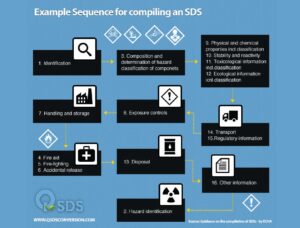
Section 1: Identification.
Identification is needed to discern the substance or mixture, its relevant uses, the name of the supplier and contact detail information.
Section 3. Composition/information on ingredients
This section describes the chemical identity of the ingredient(s) of the substance or mixture.
Section 9: Physical and chemical properties
This section includes the empirical data relating to the substance or mixture.
Section 10:
This section includes the stability of the substance or mixture and the possibility of hazardous reactions occurring, and if released into the environment. If applicable, include a reference to the test methods used.
Section 11: Toxicology
This section includes a description of the various toxicological (health) effects and the available data used.
Section 12: Ecological information
This section includes information to evaluate environmental impact of the substance or mixture. This will include test data clearly indicating test conditions.
Section 14: Transportation information
This section provides information of transportation such as road, rail, sea, inland waterways or air.
Section 15: Regulatory information
This section provides regulatory information that is not already provided in the safety data sheet.
Section 8: Exposure controls
This section describes exposure limits and risk management measures.
Section 7: Handling and storage
This section provides information for handling and storing the substance or mixture.
Section 4: First aid
This section provides first aid measures that are able to be understood by an untrained responder. This states the urgency if medical attention is required.
Section 5: Fire-fighting
This section provides requirements for fighting a fire caused by substance or mixture.
Section 6: Accidental release
This section recommends preventions and responses to spills, leaks, or exposure to persons or the environment.
Section 13: Disposal
This section includes information for proper waste management and possible disposal options of the substance or mixture and/or its container.
Section 16: Other information
This section will provide miscellaneous information that will be needed to take note of.
Section 2: Hazards Identification
This section provides hazards of the substance or mixture and the appropriate warnings.






